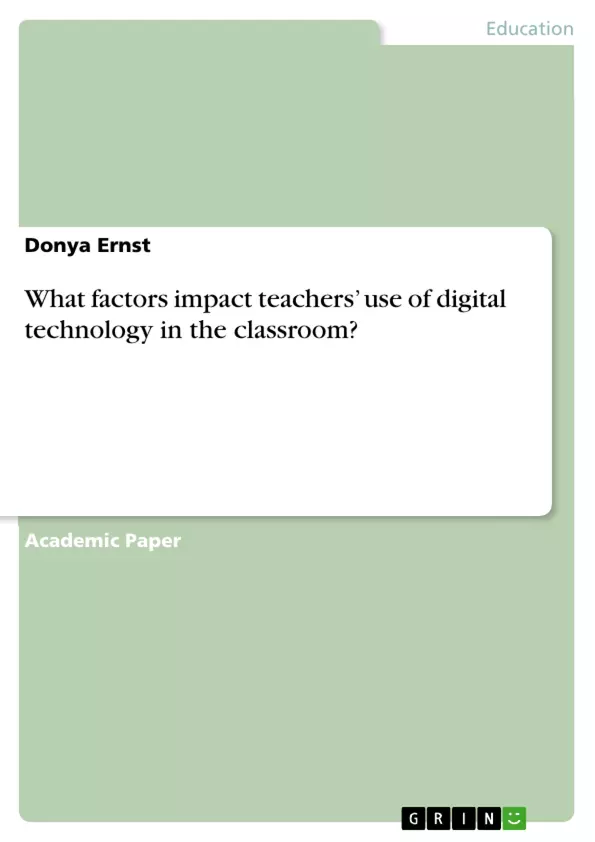The focus of this assignment is to critically analyse factors which impact teachers’ use of digital technology. Therefore, the key concepts of the proposed problem are identified and analysed as well as the approaches through a variety of perspectives are substantiated. The significance of the problem has been justified and perceived primarily through the dominant political, economic and social cultural voice where the assignment centres on.
I will analyse the conceptual nature of the problem concerning teachers’ use of digital technology through the impact on institutional ecosystems which directly affect teacher ecosystems and investigate these proposed issues. Many of these issues have arisen throughout the years, commencing from the political hierarchy i.e. funding, support (from different levels) and school cultures which have affected teachers’ needs that have not been adequately addressed. Consequently, I will rationalize and summarize the outcomes and unresolved issues.
Inhaltsverzeichnis (Table of Contents)
- Introduction
- The Conceptual Nature of the Problem
- Davis's Arena
- Background History
- Factors impacting teachers' use of digital technology
- The impact of teachers' use of technology through an ecological framework in view of Davis's Arena
- Outcomes
- Unresolved Issues
- Conclusion
Zielsetzung und Themenschwerpunkte (Objectives and Key Themes)
This assignment aims to critically analyze factors impacting teachers' use of digital technology, identifying and analyzing key concepts of the problem and substantiating these approaches through diverse perspectives. It focuses on the factors hindering teachers' non-use of technology, providing a comprehensive understanding of the impacting factors. The significance of the problem is primarily viewed through the dominant political, economic, and social cultural context.
- The impact of political, economic, and social cultural factors on teachers' use of digital technology
- The role of the ecological framework in analyzing teachers' use of digital technology
- The influence of school cultures and administrative leadership on teachers' attitudes towards technology
- The historical background and evolution of digital technology integration in education
- The interplay between teachers' expertise and attitudes in shaping their use of digital technology
Zusammenfassung der Kapitel (Chapter Summaries)
- Introduction: This chapter introduces the assignment's focus on critically analyzing factors affecting teachers' use of digital technology. It clarifies the scope of the investigation and emphasizes the significance of the problem within a dominant political, economic, and social cultural context.
- The Conceptual Nature of the Problem: This chapter explores the conceptual roots of the problem, attributing them to political, economic, and social cultural factors. It discusses the ideological importance of integrating digital technology in education and how global economic forces impact teachers' experiences. The chapter introduces the ecological framework as a crucial tool for analyzing teachers' use of technology, drawing parallels with the dynamics of natural ecosystems.
- Davis's Arena: This chapter presents Davis's arena model, which visualizes different levels of ecosystems influencing teachers' use of digital technology. It explores how factors like commercial pressures, political policies, and professional development practices affect individual teachers and their classroom practices. The chapter also highlights the resistance to change within institutions and the importance of understanding school cultures.
- Background History: This chapter traces the historical backdrop of digital technology integration in education, focusing on the significant changes initiated during Blair's ministry. It highlights the UK's ambition to become a leader in digital education and the substantial funding allocated for technology infrastructure and teacher training. It also acknowledges the challenges of ensuring effective use of technology despite the availability of resources.
- Factors impacting teachers' use of digital technology: This chapter delves into the specific factors impacting teachers' use of digital technology. It analyzes how different forces, including funding, support systems, school cultures, and teacher training, influence teachers' adoption and implementation of technology in their classrooms.
Schlüsselwörter (Keywords)
This assignment focuses on the critical analysis of factors impacting teachers' use of digital technology in the classroom. It delves into key concepts such as the ecological framework, school cultures, administrative leadership, and the historical background of digital technology integration in education. The assignment examines the impact of global economic pressures, political policies, and the evolution of digital technology on teachers' attitudes and practices. Other key themes include the role of funding, support systems, and professional development in fostering effective technology integration.
- Quote paper
- Donya Ernst (Author), 2015, What factors impact teachers’ use of digital technology in the classroom?, Munich, GRIN Verlag, https://www.grin.com/document/514605



